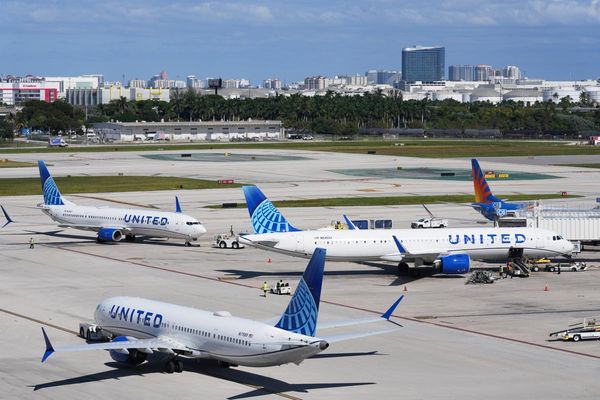
Yesterday was a tale of two scenarios.
On the one hand, you had the S&P 500 rising by 1.1%, almost hitting its all-time high of 6,147.43. On the other hand, Oxford Industries (OXM), the specialty retailer behind Tommy Bahama, Lilly Pulitzer, Southern Tide, and others, hit its 47th new 52-week low of the past 12 months.
Down 52% in 2025, and the year’s only half over, the Barchart Technical Opinion screams “strong sell.” If you believe in the axiom to “never catch a falling knife,” the struggling small-cap is off limits to most risk-averse investors.
However, if you like to gamble a little with your fun money-- funds you can afford to lose--now might be the perfect time to consider a small wager.
The last time OXM stock traded this low was in September 2020, nearly five years ago, during the midst of the pandemic. While tariffs are the culprit this time, this situation won’t last forever.
Aggressive investors should consider the company’s stock at these prices despite technical indicators suggesting otherwise.
Here’s why.
Oxford’s Financial Health Is Okay
One of the first things I do when evaluating a stock’s viability for investment is to review its current and historical Altman Z-scores. The Altman Z-Score indicates the likelihood of a firm going bankrupt within the next 24 months.
The calculation involves several items from the balance sheet and income statement, as well as the current market capitalization. A stock is considered distressed if its score is below 1.81.
According to S&P Global Market Intelligence, Oxford’s is 2.89, safely out of the distressed zone. However, it is the second lowest in the past decade, surpassed only by fiscal 2020, at 2.18.
The beauty of the Altman Z-Score is that it increases as the various inputs to the calculation rise. Conversely, it falls as the multiple inputs fall.
It’s a quick way to understand the financial health of a non-financial business. That doesn’t mean you shouldn’t do any more due diligence. You should do so, but at least you know it’s unlikely to go out of business shortly.
The company’s highest score in the past decade was in fiscal 2018, at 6.14, more than double its current score. Unsurprisingly, its return on capital at that time was 11.7%, considerably higher than the 6.3% it achieves today.
The good news is that the company’s highest return on capital was 15.7% in fiscal 2022, which was just over three years ago. It can return to or near that level with some assistance from the White House.
That Can’t Be the Only Problem With Its Business?
In fiscal 2024, the company produced 39% of its apparel and related products in China and 24% in Vietnam.
The 46% tariff on apparel imported from Vietnam has yet to take effect. The deadline is early July. Reuters reported today that Vietnamese Prime Minister Pham Minh Chinh is expected to reach a trade deal before then.
On the China front, apparel imports currently face a 55% tariff, which is based on a 10% global baseline tariff, a 20% tariff on fentanyl, and the existing 25% tariff from Trump’s first term. It’s unknown whether that will rise or fall in the coming weeks.
So, while not ideal, if Vietnam’s trade deal lowers the tariff rate, it could have been a lot worse for the company.
“Despite the increasing headwinds, we were led by a low double digit increase at Lilly Pulitzer as the brand’s current assortment is resonating strongly with its core consumer, and overall sales were only modestly lower than last year. At the same time, we were able to maintain strong gross margins above 64%,” stated CEO Tom Chubb in Oxford’s Q1 2025 press release.
Since 2014, Oxford’s gross margin has been higher in only two other quarters: 65.5% in Q1 2023 and 64.9% in Q1 2024. Despite the tariff issue, it’s performing reasonably well.
Americans are spending less on most items, including apparel, as evident in their Q1 2025 sales report. However, they were only down by 1.3%, with both Lily Pulitzer and its Emerging Brands (Southern Tide and three others) delivering growth, offset by a 4.2% decline from Tommy Bahama, which accounts for 55% of sales.
The biggest concern at this point is its SG&A expenses, which increased by $10 million in Q1 2025 to $223 million, representing 56.7% of revenue, a 320-basis-point increase from a year ago.
The good news is that most of the extra expense was to open eight new locations during the first quarter, including two of its Tommy Bahama Marlin Bars, the Food & Beverage concept it launched in 2017 in Florida.
It now has 14 locations in seven states, as well as 14 Tommy Bahama restaurants in five states. Given the success of the RH (RH) restaurant concept, it’s a worthwhile expense to attract and retain customers. In the first quarter, Tommy Bahama's Food & Beverage business accounted for 16% of its revenue and 9% of the overall revenue, unchanged from the same period a year ago.
From a diversification perspective, having four segments accounting for at least 16% of its overall revenue —Retail (45%), Wholesale (20%), E-Commerce (19%), and Food & Beverage (16%) —provides some protection from a sudden decline in any one of these segments.
The Bottom Line on Oxford Stock
If you forget, for a moment, that the apparel industry is facing a massive threat from tariffs, and objectively look at Oxford’s business from a purely numerical and valuation standpoint, there’s an argument that OXM stock is oversold.
According to S&P Global Market Intelligence, OXM stock has a Relative Strength Index of 26.93. Anything below 30 is considered oversold, and anything above 70 is overbought, rendering it oversold relative to the S&P 500, which has a current RSI of 66.56, just a few basis points below 70 and oversold territory.
Working against OXM stock: of the six analysts covering Oxford, none rate it a Buy (5 Hold and 1 Strong Sell), with a target price of $47.50, about 30% higher than where it’s currently trading.
Assuming they’re correct, let’s consider this possible options strategy where you combine a synthetic long position with a protective or long put.
In this example, the strike price of the long call and the short put should be the same, at-the-money (ATM) or close to it, with the same expiration date. The long put should have a lower strike price than the short put. It can have a different DTE (days to expiration), but should generally be the same or close.
As I write this in the afternoon trading, OXM is down 1.8% at $37.37, so we’re looking for a strike price of $35 or $40.
The $40 strike, expiring on July 18, has volume today for both the call and the put, so let’s go with that. The long call’s ask price is $1.10, while the put’s bid price is $3.70, for a net credit of $2.60 [$3.70 bid price - $1.10 ask price].
You then have to buy a long put with a strike price below $40. Let’s say $35. The ask price for the put is $1.55, reducing your premium income to $1.05.
If the share price reaches $50 at expiration, you will earn $11.o5, representing a 29.6% return [$11.05 / $37.37] or a 470% annualized return [29.6% * 365 / 23].
1) The $40 short put expires worthless. You keep the $3.70 premium.
2) The $35 long put expires worthless. You paid $1.55 for it. It also expires worthless.
3) The gain on the $40 long call would be $8.90 [$50 share price - $40 long call strike price - $1.10 ask price].
If the share price falls to $24.66 (the equivalent amount on the downside), you lose $3.95 [$11.34 loss on $40 short put - $8.79 gain on $35 long put + $1.10 loss on $40 long call].
1) The $40 short put expires ITM (in the money). You are asked to buy the 100 shares at that strike price. However, they’re only worth $24.66 each. That’s a loss of $15.34. Subtracting the $3.70 premium, your loss is $11.64.
2) The $35 long put expires ITM. You paid $1.55 for it. Your gain on this part of the trade is $8.79 [$35 long put strike - $24.66 share price - $1.55 ask price].
3) The $40 long call expires OTM and is worthless. It cost you $1.10.
The problem with this trade is that Oxford’s stock has low options volume—its 30-day average is just 532—so obtaining favorable prices won’t be easy.
Alternatively, you could buy 100 shares of OXM stock at $37.37 or thereabout and protect the downside by purchasing the $35 long put for $1.55, approximately 4.1% of its share price.
Either way, if you’re an aggressive investor, Oxford stock is priced to move.
On the date of publication, Will Ashworth did not have (either directly or indirectly) positions in any of the securities mentioned in this article. All information and data in this article is solely for informational purposes. For more information please view the Barchart Disclosure Policy here.






